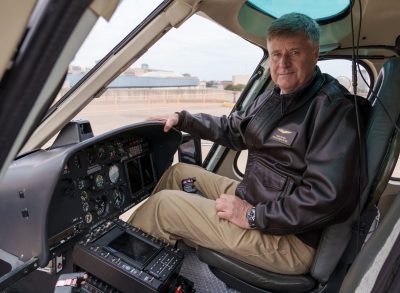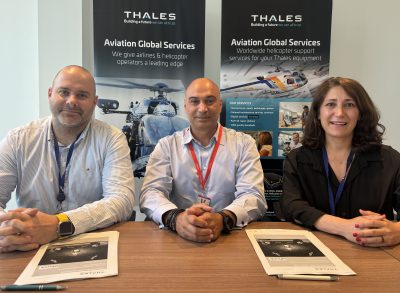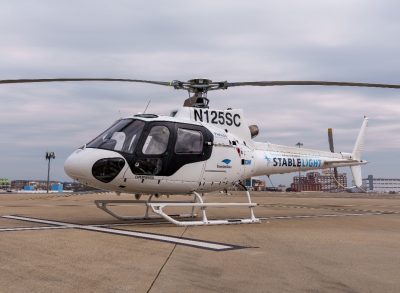HeliExpo 2017: Thales unveils its newest solutions
On the opening day of the HeliExpo 2017 exhibition, we spoke to Christian Bardot, Vice President, Helicopter Avionics, to find out more about the innovative solutions that Thales is presenting this year.

The helicopter market may be seeing the beginning of the end of traditional cockpit architectures. Pilots and operators are increasingly looking for mission-oriented cockpits s and want relevant information to be displayed only when needed and in a mission-friendly way. That is why connected Avionics 2020 is their future. Flying most of their missions close to obstacles and in adverse conditions, "eyes out" systems are a natural complement to connected Avionics 2020 and will be key in the future for rotorcraft operations. Developed for the military market for decades, the technology is now mature, it’s a natural evolution to render this offerable to the civil market. Inspired by the TopMax head-worn display unveiled in 2015, and having received positive initial feedback from test pilots, we are convinced that these eyes out systems are set to become a mainstay of the industry.
Advanced helicopter autopilots have long been considered too costly for the rotorcraft industry and have been used almost exclusively in the twin-heavy segment and on high-end platforms. Demanding missions like search & rescue, emergency medical services and homeland security call for low-level flight and safe operation even in complex situations and bad weather. These missions would invariably benefit from an advanced autopilot solution to avoid accidents — and our compact autopilot is perfectly suited to these needs.
Avionics 2020 is said to be the world’s first fully connected cockpit for helicopters. Can you tell us more?
We are positioned as the market leader in all aspects of connected aircraft. The new systems we are presenting this year integrate open-world information with secure avionics. They are designed to make the pilot’s mission easier, safer and more efficient by providing the right information to the right people at the right time. With an open-world architecture, operators are no longer tied to any particular supplier of mission applications. This approach opens up the market to more competitors, drives innovation and creates more value for users.
What kind of open world information can be displayed?
For missions like emergency medical services, for example, an open-world architecture will support telemedicine applications, with functions such as voice conferencing and live transmission of patient telemetry data from helicopter to hospital specialists. Emergency crews can receive live information about the accident zone (obstacles, best landing location, etc.) and obtain real-time hospital dispatch information so they can fly directly to the right place.
For homeland security and search & rescue operations, enhanced functionalities such as over-the-air video downlink across 4G or satcom networks will be used to share live airborne video from helicopter to command centre. This will help to optimise coordination of rescue teams, police forces and security services.
During routine shuttle flights, transport of VIPs or oil & gas missions, onboard connectivity will provide helicopters with IFE and office-in-the-sky capabilities across standard Wi-Fi protocols.
Last but not least, cyber protection will be key, especially during downloading/uploading of software apps and data.
You’ve mentioned the TopMax visor. What is the difference between TopMax and your new eyes-out solution for helicopters?
The eyes-out solution for civil helicopters is the latest evolution of a trend that started with our proven military solutions like TopOwl and Scorpion. Inspired by the TopMax visor for civil fixed-wing pilots, which we unveiled in 2015, this new solution has been specifically designed for civil helicopter pilots. Its architecture is tailored to maximise efficiency in stressful situations, in daylight and at night, particularly during complex missions such as emergency medical services and search & rescue.
The helicopter solution uses high-accuracy hybrid inertial/optical position tracking technology for passive integration in cockpits, and delivers conformal symbology that can be adapted to any kind of mission. It is a lightweight system that is easy to integrate and suitable for all types of helicopters. Pilots can focus on their surroundings during critical parts of a mission without having to look down at the instrument panel, and this has a measurable effect on safety and security.
This year you are also unveiling a new autopilot. What are its main characteristics?
Autopilots are a key safety and efficiency enhancer. Thales has been at the forefront of this technology for more than 60 years, ever since we developed the autopilot for Concorde. Our new compact autopilot for helicopters is the smallest and lightest autopilot on the market and can be fitted to all sizes of rotorcraft both as a line-fit or a retrofit system. Its innovative architecture fully integrated within actuators eliminates the need for dedicated computer, making the entire system much lighter and cheaper. Smart actuators can be configured for advanced modes like hover and departure, reducing the pilot’s workload by providing stability augmentation, attitude retention, and altitude and heading hold capabilities. The new system brings the advanced functionality of top-end autopilots within reach of civil helicopter operators everywhere.
More information about the compact autopilot for helicopters available here.
Stay connected with us...
Find us on Twitter @ThalesAerospace, on our official Youtube channel Thales Aerospace and on LinkedIn Thales Aerospace.




